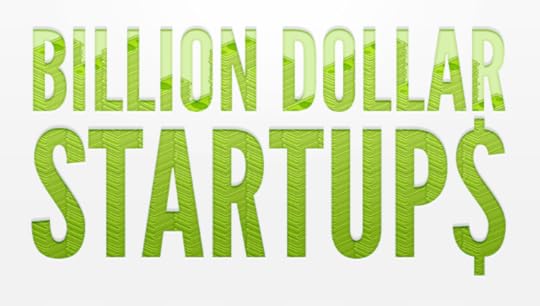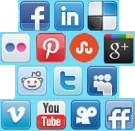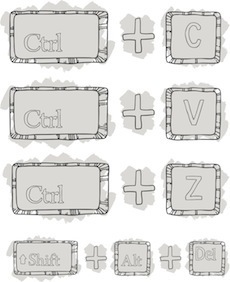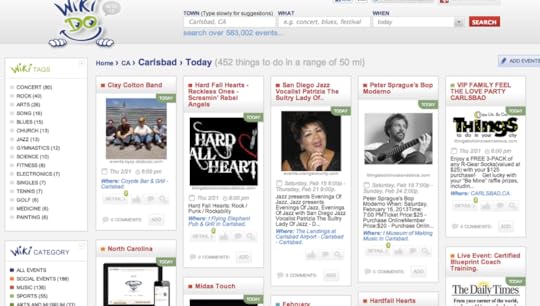Erik Qualman's Blog, page 640
February 27, 2013
Being Older Does Not Mean You Can’t Be Social

 Many of those in their 30′s and 40′s may think of their parents or grandparents as being a little too uncool to be involved in social networking in 2013. If you’re one of those thinking that way, think again.
Many of those in their 30′s and 40′s may think of their parents or grandparents as being a little too uncool to be involved in social networking in 2013. If you’re one of those thinking that way, think again.
As some surveys have shown in recent years, those deemed by many to be too old or interested in social media are proving many wrong.
According to a Pew Internet study from 2012, last year was forecast to be the third straight year whereby social media usage for both baby boomers and seniors would see growth among its active users.
The study noted that of older adults spending time online, half of those ages 50-64 claim to be more active in social media. A larger increase from the prior year showed that more social media users were those ages 65 and older, many of whom turn to Facebook, Twitter and Pinterest for their social networking activities.
With those results in mind, just what might seniors be doing with social media when they login to the various sites?
Some of the ways seniors can utilize and benefit from engaging in social networking include:
* Family connections – With many families spread out these days, seniors can stay in touch with their kids and grandkids through sites such as Facebook, Twitter, and Pinterest among others. While many senior citizens still enjoy the idea of writing letters, others have taken in recent years to getting online and sharing thoughts, photos and videos with their loved ones;
* Better health – Before the Internet, seniors typically had to rely on visits to the doctor and/or health care information from magazines and television. Now, older individuals can turn to social media sites and get links to health studies, reports and healthcare websites. In doing so, they can typically find answers to their questions and issues in just a few keystrokes;
* Safety measures – Social media sites are also good places to go for links to safer living for seniors. Given the fact that senior citizens are often targeted as crime victims, seniors can visit social media pages of their local law enforcement agencies to get tips on preventing crime before it happens. They can also talk with law enforcement personnel through sites like Facebook and Twitter to ask safety questions;
* Everyday concerns – While aches and pains happen to younger people, many seniors oftentimes find themselves moving a little slower or just plain feeling a little older as they age. By turning to different social media pages, they can find answers for common issues such as eating healthier, gray hair treatment, getting more exercise, and finding affordable health insurance rates.
No matter what senior citizens might need in today’s world, there is a very good chance that being more social can point them in the right direction.
Photo credit: umfk.edu
[image error]
Why Brands Should Always Consider Mobile

In the age of smart phones, tablets, and constantly being “on the go,” brands need to consider how best to distribute content – where, when, and how. Distributing content on a blog, on a website, on Facebook is one thing – but is it mobile friendly? Can someone view easily? Share easily? All things to consider when considering a distribution strategy for content and content consumption by the target audience.
Content varies from blog posts to tweets to video to infographics to…so much more. In the case of video, mobile consumption is growing each year. Currently according to YouTube:
25% of global YouTube views come from mobile devices
People watch one billion views a day on YouTube mobile
YouTube is available on 400 million devices
Traffic from mobile devices tripled in 2011
Video content tells the brand’s story – whether it’s on YouTube or a quick snippet on vine – and of course they’re both shared across social. Both are meant for mobile so it’s important to ensure mobile friendliness when you are embedding on your sites – check to see that your site is either a mobile site or a responsive web design which adjusts to screens accordingly.
If you aren’t considering mobile – you’re losing audience members, you’re losing engagement, you’re losing the value ofy our content. In one word – Fail.
Rather than losing out – when it comes to video content and focusing on mobile consumption consider the following when strategizing: (1) short and digestible content; (2) uploading 2 hours before the optimal viewing time for your audience; (3) second screen opportunities for engaging your audience when watching TV (ex. extended content or behind the scenes); and of course (4) ensuring your content is easily shareable across your audiences’ preferred social networks.
Questions or Comments on how your brand strategizes for mobile? Let us know in the comments section below.
Image sources: http://readwrite.com/2012/08/22/youtu... http://www.midbeam.com/articles/play-...
[image error]
February 26, 2013
The Billion Dollar Startups

There are not many startups that made it to a billion dollar valuation, but here are the few that did make it. We’ve only included companies that started in 2004 and onwards (the year when Facebook was founded).


[image error]
February 25, 2013
How to Use WikiDo To Help Promote Your Business

 WikiDo seems to have been flying under the radar for quite some time; however that isn’t because it isn’t a useful tool. In fact, most people are unaware of what WikiDo even is; let alone how to use it or why it’s important. In a nutshell, WikiDo is a search engine specifically designed for events in your city. Because the search engine focuses solely on events, it’s easier to manage than Google (not to mention it has the clarity that so many love about Wikipedia). This leads to several questions: Where do you find it, how exactly does it gather data, and how can businesses benefit?
WikiDo seems to have been flying under the radar for quite some time; however that isn’t because it isn’t a useful tool. In fact, most people are unaware of what WikiDo even is; let alone how to use it or why it’s important. In a nutshell, WikiDo is a search engine specifically designed for events in your city. Because the search engine focuses solely on events, it’s easier to manage than Google (not to mention it has the clarity that so many love about Wikipedia). This leads to several questions: Where do you find it, how exactly does it gather data, and how can businesses benefit?
The Who, What, When, Why and How of WikiDo
Before jumping into how businesses can benefit from WikiDo, it’s important to understand just how the service works. Below are a few details about WikiDo that users might need to know:
The Who: WikiDo works similarly to Wikipedia in the sense that anyone can insert events or edit the information on the site. It’s free to do so, and all you need to do is click on the “Add Events” button after registering to make it happen. The site also uses an algorithm to find events mentioned across the web. National websites such as CBS Local help provide some of the information, and the site makes it easy to click on a listing to learn more.
The What: As stated above, WikiDo is a search engine focused on events in any particular city. In total, the search engine has over 750,000 events listed in categories like social events, music, sports, food and drink, and many more.
The When: WikiDo was launched in October and has remained ad free since 2013. It’s important to understand that the tool is incredibly new, having only been around for four months, so it’s still in beta testing.
The Why: Local events are always looking for an outlet to gain some publicity, and WikiDo is trying to make this happen. It’s an easy place for people to come and narrow down different events in even the smallest of towns.
The How: All a user needs to do is enter the name of a city and then determine the type of event that you want to see by clicking boxes you’ll see on the left hand side of the screen. You can also break down the events by category. Results will show up in a Pinterest-like fashion as shown below:
How Businesses Can Take Advantage of WikiDo
There are really two major ways that businesses can take advantage of WikiDo, and it all depends upon the type of business that you run. You could either:
Add an Event. If your company has an event coming up, it’s a no-brainer. Head over to WikiDo and add the details of your event. It’s much easier to get approved here than the traditional Wikipedia because it’s your event—you’re always going to be right!
Attend an Event. Seeing what events are happening in your community might be a great way to get your company some visibility. Attend these community events and get to know those around you. You might be surprised at just how many connections you make. After all, it’s all about networking in 2013.
Have you ever used WikiDo in the past? Did you have a good experience, or were there some things that you still found confusing? Let us know your thoughts in the comments below.
Photo Credit: wikido.com
Amanda DiSilvestro gives small business and entrepreneurs SEO advice ranging from keyword density to recovering from algorithm updates. She writes for HigherVisibility , a nationally recognized SEO consulting firm that offers national and local SEO services to a wide range of companies across the country.
[image error]
3 Rules to Remember Before You Post Online


For each social media platform, there are particular rules you must remember before you post a message.
As social media users, we engage on different networks because something has attracted us to it. Perhaps you use Facebook to view photo albums of your friend’s baby as she grows up; or you use LinkedIn to engage with potential employers at your dream company; or you follow play-by-play hockey updates on Twitter.
Whatever your reason, you likely use social media because it fulfills a need. HOWEVER, sometimes we see posts that do not fulfill a need, and instead leave us wondering, “Why did someone post that?!”
Here are three things you should always think about before you post:
#1 Double Check Your Post BEFORE You Send It
Always, always, always double-check your post before you hit that send button. You never know if you may have accidentally forgotten a letter, or if you accidentally added one. Use a spellchecker if you need to, and since most applications and websites have spell check, there is no excuse.
Here’s a special, secret trick to help you double-check this: read your post out loud as if you were saying it to someone. Yes, it sounds a bit crazy, but it works. When you are speaking out loud, you can hear whether or not a sentence flows smoothly, and maybe you’ll realize that you actually forgot to type out a common word, such as “if” or “to”, in your sentence. This mistake is more common than most people realize, so always double-check!
#2 Follow the Rules and Etiquette of Each Network
Different websites have different rules, and although I don’t expect anyone to know them all by heart (is there anyone?!), you should know the basic rules and etiquette of each network that you participate on. Mainly, everyone should try to understand and remember what kind of post is appropriate for each website.
For example, if you finally landed your dream job at your dream company, share it! That type of post is even appropriate enough for LinkedIn – well, probably most appropriate for LinkedIn, actually. If you found an awesome dress on sale that you’re going to wear to a crazy house party this weekend, that is NOT LinkedIn appropriate! Save that for Facebook or Instagram.
Simply, think about what you want to share, and WHO it is appropriate for. Don’t make the mistake of sharing inappropriate content on the wrong social network and losing out on potential, life-changing opportunities.
#3 Share Content that is Worthy
Everyone has a different idea of what is “worthy”, so you will have to decide for yourself what this means to you, and more importantly what it means to the people who connect with you online.
I love seeing pictures of my friend’s new puppy. I do not love seeing 80 pictures of my friend’s new puppy sleeping, in the same position, in every picture. An easy way to filter out content that is not “worthy” is to think about whether or not the post would engage you. Would you go through an album with 35 photos of your friend’s new hair style, which was actually just a trim, and looks exactly like it did before? Probably not, so try to avoid sharing that type of post with your friends and followers.
Remember: you should always try to share content that is exciting, new, important, funny, amazing, or engaging.
For more social media tips, visit www.socialmediatips.com where you will discover all the tips you could possible need.
Know another social media rule that everyone should follow? Share it in the comments below.
[image error]
February 21, 2013
15 Keyboard Shortcuts that Will Save You Time

Whether you spend the majority of your day working with computers  professionally or just write the occasional report, it goes without saying that writing projects can be a bit time consuming. When you’re up against a tight deadline and every minute counts, finding ways to shave a few seconds off of every task you tackle can add up big time over the course of your work. These 15 keyboard hacks are effective shortcuts that can help you power through your work so that you come in on the right side of every deadline. These are for PCs, but many work on Macs, but use the command key instead to Ctrl.
professionally or just write the occasional report, it goes without saying that writing projects can be a bit time consuming. When you’re up against a tight deadline and every minute counts, finding ways to shave a few seconds off of every task you tackle can add up big time over the course of your work. These 15 keyboard hacks are effective shortcuts that can help you power through your work so that you come in on the right side of every deadline. These are for PCs, but many work on Macs, but use the command key instead to Ctrl.
Ctrl + A – When you need to select the entire body of a document, using the ctrl+A command will allow you to do so instantly. No scrolling to find the home point and dragging to the end to select all of the text.
Alt + Tab – The need to quickly cycle through all your open applications can strike at any time, which is where this keyboard hack comes in handy. Without removing your hands from the keyboard to fumble with a mouse or touchpad, you can make quick work of looking through additional resources.
Ctrl + F – Finding a particular keyword in a sea of text can be like searching for the proverbial needle in a haystack. Rather than wasting valuable time sifting through pages of text, simply use the ctrl+F shortcut to locate every occurrence of a particular word within the selected document.
Ctrl + X – Cutting text from one source to paste in another doesn’t have to require a series of clicks to navigate through an edit function window. This shortcut instantly cuts the text, leaving it ready for you to paste wherever it’s needed.
Alt + Arrow – When you’re searching the Internet for resources or research purposes, you don’t have to navigate back and forward with the mouse. Hitting the alt key, along with either the left or right arrow, will take you where you need to go.
Alt + Spacebar – If you need to maximize, minimize or close a window without removing your hands from the keyboard, the menu is opened for you without the aid of the mouse when you use the alt+spacebar shortcut.
Ctrl + Z – We all make mistakes from time to time. When you need to quickly undo the last action in a document, ctrl+Z is a much more efficient use of your time than navigating through several layers of the menu to accomplish the same task.
Ctrl + Y – It’s easy to get carried away with the Undo function, especially after you’ve discovered the best way to do it quickly and efficiently. When you’ve been a bit overzealous with your newfound skill, hitting the ctrl+Y keys can restore an accidental undo.
Alt + Esc – Quickly jumping from one program to the next without reaching for the mouse is as easy as alt+esc!
Ctrl + End – You can lean on the down arrow key until your cursor finds its way to the bottom of a document or scroll through pages with your mouse or touchpad to get to your destination. If neither of those options is speedy enough, you can also press the ctrl and end keys simultaneously.
Ctrl + Shift + Arrow – Selecting one word surrounded by myriad other characters doesn’t have to require careful mouse work. Just position your cursor in a nearby position, and press this combination of keys using the appropriate directional arrow.
Alt + F4 – When you need to close the top open window, you can look for the small “x” and click on it with your mouse, or you can use this shortcut to do it immediately.
Ctrl + B – Adding emphasis to text by using a bold face is a great way to make a particular word or phrase stand out. Selecting the word or phrase you want to emphasize and then using this shortcut immediately casts the type in bold face.
Ctrl + C – If you’re working on multiple projects with similar aims or are simply using more than one program to complete a single project, you’ll probably need to copy and paste at some point. This shortcut allows you to copy selected text quickly and easily.
F7 – When you’ve dedicated hours to a project in hopes of turning out a perfect product, you’ll want to make sure that you run the spellcheck function to catch any spelling errors that could spoil your efforts. Most programs have a dedicated button on the toolbar for ease of use, but you can also hit the F7 key as an extra-quick shortcut.
Source: Longhornleads.com
[image error]
February 20, 2013
10 iPhone Apps to Keep Track of What You Like and What You Don’t

 Whether you’re just trying to keep up with your opinions for your own purposes or are looking to share them with the world at large, the same device that helps you streamline your professional life and manage a variety of business tasks can help you log your likes and dislikes as well. These 10 apps can help you store and share your opinion on anything you can think of.
Whether you’re just trying to keep up with your opinions for your own purposes or are looking to share them with the world at large, the same device that helps you streamline your professional life and manage a variety of business tasks can help you log your likes and dislikes as well. These 10 apps can help you store and share your opinion on anything you can think of.
I Loves It! – The developers of this free app encourage users to skip sharing things that they like, saving their energy for things that they love. Users can share pictures of the things that they “Loves,” add a short description and send it to anyone on their contacts list. Recipients of information about the things that you Loves don’t have to download the app to see your alerts, and you can keep track of those things you’re fond of by looking through your logged Loves history.
Thumbs Up App – Television enthusiasts rejoice, there’s finally an app for you to share your real-time reactions and opinions about the shows of your choice! Free from developers Fluid Life, Inc., the Thumbs Up app allows you to share your reactions and keep track of everything you liked or didn’t like about each episode of your favorite shows.
Untappd – Are you a craft beer lover? If so, this free app is for you. After helping you find the bars and stores that sell craft beers in your area, review information about beers that are trending and see what your friends think about the beers they’ve recently tried, Untappd lets you track, rate and even photograph beers as you try them. Earn badges as you let the world know which beers you like and which you don’t!
Yelp – Not only can you search for businesses in your area with the free Yelp app, you can also let the world know whether you liked them or not. Leave reviews for stellar service, record a negative experience and keep track of all your local likes and dislikes!
We Heart It – If you want to curate inspiration boards and galleries with images of the things that you like, this free app is for you. Integration with Tumblr, Facebook and Twitter allows you to share your love of something with all of your followers, while organization features help you group images by theme or subject so you can always keep up with the things that you’re loving.
Momento – Sometimes, you need the freedom of a diary or journaling app to truly capture your feelings of approval or disdain. This $0.99 app allows you to do just that, maintaining a diary filled with your various likes and dislikes. You can even import and archive your online activity to display as part of a journal entry.
Dislike It! – Facebook might be one of the most popular social networking sites in the world, but it still only allows you to “like” things. With this free app, you can take pictures and upload them with a “dislike” badge, letting everyone on your friends list know exactly how you feel about something.
Goodreads – Avid readers can now update their Goodreads accounts on the go, sharing your literary likes and dislikes from anywhere that has an Internet connection. You can even add books to your list with a barcode scanning feature, uploading your opinions quickly and easily.
Evernote – If you need to keep tabs on things that you or someone important to you like or aren’t so wild about, the free Evernote app will let you do just that. You can even collect notes into customizable categories, keeping the information at the tips of your fingers for quick reference.
Pinterest – Find things that you like and add them to your Pinterest boards, or file images depicting things that you aren’t so fond of to a customized board. You can even pin from your camera, allowing you to snap photos of things as you experience them, sharing your opinions with the world and keeping tabs on them for later reference.
If one of the things that you don’t like is risky behavior or chancing a pricey citation, you’ll remember not to use these apps while you’re behind the wheel. Even if you feel your dislike of something is so strong that a sternly-worded review needs to be fired off immediately, you should keep in mind that your safety and that of other drivers on the roads trumps even the worst service.
Source: http://www.parttimenanny.org/blog/10-iphone-apps-to-keep-track-of-what-you-like-and-what-you-dont/
[image error]
February 19, 2013
Will That Customer Cost Me Business?

 It can be your greatest wish or your biggest nightmare.
It can be your greatest wish or your biggest nightmare.
How many times as a company owner or head of an organization have you wished for customers to spread the word about you and your business online, only to discover that some of them had some not so kind things to say about you on social media? For the man or woman in charge, it just takes one tweet or share to shake up their world in a negative way.
According to Gartner Inc., by next year, organizations refusing to talk with customers via social media will be dealing with the same magnitude of wrath from customers as those that turn a blind eye to today’s simple notion that they will get back to emails and phone messages. Gartner predicts that the dissatisfaction coming from the failure to get back to customers through social media can lead up to a 15 percent jump in churn rate for present customers.
So, where does your business stand when it comes to replying in a timely and appropriate manner to customers who have a question, issue, and even a beef or two?
If you are having problems getting social media right when it comes to this subject, keep some of these ideas in mind:
* Customer isn’t always right – Despite the old adage that the customer is always right, just about everyone knows that not to be true. That being said, you still have to approach each case like that is the sentiment, especially if you want to keep that customer’s business coming your way;
* Time is of the essence – One of the major gaffes that businesses and organizations make in this scenario is not responding to the customer in a timely manner. By not doing so, you give them reason to think their business is not that important to you. When that happens, they may end up figuring their money may be important to someone else;
* Professionalism is key – Never make the mistake of being unprofessional when responding to a customer matter via social media. Unlike a phone call or even email that is essentially a one-on-one exchange of thoughts and opinions, a tweet or share that you send out publicly can be viewed by countless eyes. In the event you take a negative tone with a customer through Facebook, Twitter, and other social venues, you run the risk of damaging your business reputation in front of many people, some of whom may be potential customers;
* Have a plan in place – Do you let others in your company or organization respond to customer complaints through social media? If the answer is yes, by all means make sure everyone on your team is on the same page. For this very reason, many companies do not allow employees to represent the company in responding to customers, even telling them not to respond via their personal accounts;
* Be a solution provider – Last but not least, find a solution to the problem that works for both the customer and your company. Face it, losing a customer here or there may not seem like much, but then add those numbers up over time, and you will see some negative impact on your revenue stream. While some customers will never come back no matter how much you bend over for them, there are many others who just want to see some time and effort from you to deal with their issue with your company. Isn’t it worth it to be a solution provider who is also a little social too?
Photo credit: angrycustomer.org.uk
[image error]
10 Ways to Test Who You’re Really Chatting With Online

 The sad tale of Manti Te’o and his fraudulent girlfriend has brought a problem with online dating to light: the risk of catching a catfish. “Catfish” is the term used to describe a person who poses as someone they’re not in order to establish a relationship with an unsuspecting online dater. These scams can be carried out for financial gain, or simply to fulfill a need for acceptance and love that the catfish isn’t feeling in their actual lives. Whatever the motive, perpetrating such a ruse can have heartbreaking effects on the targeted party. If you’re in an online relationship or considering one, here are 10 ways to guard yourself against a catfish scam.
The sad tale of Manti Te’o and his fraudulent girlfriend has brought a problem with online dating to light: the risk of catching a catfish. “Catfish” is the term used to describe a person who poses as someone they’re not in order to establish a relationship with an unsuspecting online dater. These scams can be carried out for financial gain, or simply to fulfill a need for acceptance and love that the catfish isn’t feeling in their actual lives. Whatever the motive, perpetrating such a ruse can have heartbreaking effects on the targeted party. If you’re in an online relationship or considering one, here are 10 ways to guard yourself against a catfish scam.
Web Search – Some people hesitate to “Google” their new online sweetheart for fear of invading their privacy. The truth is, a quick web search may turn up a few pieces of information that confirm your significant other’s identity. You don’t have to pry or dig into personal backgrounds with in-depth reports. Just run a quick search and see what comes up.
Insist on Video Chats – When someone you’re dating online dodges webchats for an extended period of time, it’s often an indicator that she isn’t who she claims to be. It’s understandable to be hesitant about webchatting in the earliest stages of a relationship, but it’s a bit fishy when she’s professing her undying love but still dodging the camera.
Read Between the Lines – It’s easy to miss signs that are literally right before your eyes when you’re swept up in the excitement of a new romance. Before you get too emotionally invested, make a habit of reading between the lines of what he says and listening to what he doesn’t say. Fabricating an entirely new personality isn’t easy and you may be able to pick up on some subtle warning signs.
Their Facebook Wall – Creating a fake Facebook profile is easy, but making it look genuine is not. When you scan your new sweetie’s Timeline, look at the things posted there. A plethora of games and app requests combined with a dearth of personal postings may be a red flag that the person you’re dating doesn’t actually exist. Think about the things that your own friends and family members post on your wall; if they’re missing from his, it may be because the fictitious character you’re chatting with has no friends or family.
Critical Thinking – When emotion takes over, it’s difficult to think about things objectively and use your own common sense regarding the situation. In many cases, however, an entire false relationship could have been avoided with a bit of old-fashioned critical thinking. If something doesn’t seem to add up, it’s usually because there are holes in the story.
Trust Your Instincts – Your own instincts are a powerful detection tool, but they may be hard to follow when you’re focused solely on your emotions. Having a hunch that all is not what it seems or a nagging feeling that something is off with your new relationship is a sure sign that you should dig a bit deeper before investing further.
Look for Photo Tags – Group photos posted on Facebook or other social networking sites that include your honey, but have none of the other members tagged, can be a sign of a stolen picture. To realistically fake a fully-tagged group shot, a catfish would have to create and maintain that many fraudulent accounts. In the end, even the most dedicated sweetheart scammers probably won’t have that kind of time on their hands.
Use Dating Sites With Verification Services – To help stem the tide of con-artist heartthrobs, some online dating sites are offering verification services that ensure an account holder is who they claim to be. Using these sites to meet someone allows you an extra layer of security against catfish scams.
Be Wary of Elaborate Excuses – Car trouble or bad weather are par for the course in anyone’s life, but if your online girlfriend keeps putting off meetings or webchats because she’s been in a coma-inducing car accident before being sucked into a tornado and swallowed by a tsunami, there’s a good chance there’s a bit of dishonesty going on. Elaborate, over-the-top tales of woe are a trademark move of relationship scammers and can be a very reliable indicator that you’re not talking to the person who you think.
Pay Attention to Detail – Keeping track of all the many details that are necessary to convincingly fake an entire personality and life history is amazingly difficult. Simply keeping an eye out for details that don’t add up or stories that don’t fit into a proper timeline can give you all the evidence you need of an Internet sweetheart that’s not shooting straight.
In the interest of protecting your assets, it’s wise never to send money to someone you’re dating online and have never met in person. Online dating is a legitimate way of meeting and establishing relationships with open and honest people, but there is a slight chance that you’ll come across a huckster or two before you meet your intended.
Source: Longhornleads.com
[image error]
February 18, 2013
Will the Internet Replace Cable TV?

When friends and neighbors seem to get better and more TV than you do without paying for cable, it’s easy to feel left out of the media loop. “Leaving something out” is exactly what more viewers are choosing these days – they’re cutting the umbilical cord to their cable TV subscriptions.
Viewers are spending more time taking in media than ever before, according to a 2012 year-end media report from Nielsen, but they aren’t necessarily using their TVs to do so. People are accessing their entertainment programming via the Internet and on mobile devices, at home and on the go. The Nielsen report shows viewers are choosing both live and recorded shows and both free and paid content.
The Second-Screen Experience
But if viewers are so busy unplugging from traditional cable TV, how is it that TV is managing to nudge open the door to a new social TV era? The rise of the second-screen experience, where viewers interact with a show’s content and each other on social media via a tablet or smartphone, is the force at work here.
“I would say the biggest shift in the last two years is that the [second-screen] experience used to be layered on to the program as an aftereffect,” David Anderson, senior vice president and head of digital at Shine America, said at the International Consumer Electronics Show 2013. “But now when we go into a network pitching a show, we go in there with components that might be a creative fit… We view them as part of show.”
Indeed, just last month ESPN Deportes debuted #Redes, a show it calls the “first live multi-screen viewing experience geared towards the bilingual Hispanic sports fan.” Show topics are drawn from social media trends spotted on Twitter, Facebook, YouTube and other social media, with data and content presented as part of the show’s interactive material.
The Cart or the Horse?
Some thought leaders believe that TV, not the digital social media element, is the hot factor in the social media equation. “Live television is more vital a platform than digital and new media,” said Mark Cuban, president of cable network AXS TV, at the January 2012 NATPE/Content First conference.
“Television has a huge advantage in the social media world … Now viewers are sitting with devices on couches – tweeting, posting on social media, and using television as instigator for all of that. TV is a starting point for conversations. When you watch TV, you are getting a unique experience that you can’t get online.”
Cuban described must-see events and programming as the key to bringing cable back into the social TV loop. “If you want to watch that Tiesto concert, or the Skrillex concert… or the Jay-Z concert live on AXS TV,” he said, “you’ve got to get cable. If you want to be part of the conversation that all your friends with cable are part of on [social media], you’ve got to have cable.”
Between a Bundle and a Hard Place
While many consumers are hoping for a day when they can buy the channels and shows they want à la carte, Cuban denied that bundled plans will decline in popularity. “À la carte would make it so expensive for the consumer that you would just kill television,” he said. “People like bundles. People don’t want to have to work for their entertainment. You pay a premium for it because it saves you time.” According to www.cable.tv, he’s right; all the major cable providers offer viewers bundling options that enable them to purchase multiple services together.
Still, pulling the plug on cable doesn’t seem to be inconveniencing those who are giving it a try. “We ditched costly TV a year and a half ago and don’t miss it at all,” commented Atlanta-area resident LC on a blog post at the Atlanta Journal-Constitution. “We have an antenna for football games and occasional news and pay for Netflix and Hulu subscriptions also. We watch TV when we want and don’t feel like we are missing anything.”
For many, the concern is less about what they might be missing without cable than the perplexing conundrum of pricing bundles that run higher for Internet alone than with cable. “We tried to cancel our cable, but the cost to have Internet alone would end up costing us something like $23 more a month than we currently pay for both Internet and cable,” wrote reader WK in the article’s comments. “We have to have fast, reliable Internet since my husband works from home.” Users trapped by bundle pricing predicaments are making do with slower service tiers (often sufficient for streaming) and using cell phones as mobile hotspots.
When consumers do miss their old broadcast channels, they’re increasingly turning to an old standard: broadcast TV. Nielsen reports that while exclusive over-the-airwaves TV viewership was falling by 16 percent back in 2003, that retreat slowed to just 9 percent in 2012, as viewers discovered that an antenna costs about $25 and can provide as many as 40 channels entirely free.
Traditional Cable TV is Still in the Game
While the media continues to trumpet the growing influence of social TV, with more viewers disconnecting from cable and seeking an à la carte media experience, it might be more accurate to characterize this transition as a time of rugged individualism. Consumers are riding out the end of the cable era as they search for content that’s more interactive and increasingly social, driven by a desire to pinpoint and share the specific content they want.
[image error]




